Rethink Presents Lessons for Manufacturing Leaders

Are you grappling with the fast pace of competition in manufacturing? Are you working to keep up with the massive amount of disruption brought on by artificial intelligence, advanced robotics and digital breakthroughs? Are you racing to create new competitive advantages by using the power of Manufacturing 4.0—the next wave of industrial progress based on digitization?
The NAM has you covered with Rethink: The Manufacturing Leadership Council Summit, on June 22–24.
What it is: Rethink is the premier conference on Manufacturing 4.0 for industry leaders as they continue to navigate disruption. Hosted by the Manufacturing Leadership Council—a member-driven, global business leadership network dedicated to senior executives in the manufacturing industry—the summit offers participants strategies and solutions that are designed to advance their operations and improve their competitiveness.
Why it matters: The COVID-19 pandemic supercharged some of the changes that were already occurring in the manufacturing industry. Across the past year, businesses have seen an even greater need for flexibility, agility and speed in operations, and many manufacturers have accelerated their adoption of digital technologies to achieve these goals.
What it includes: The summit will offer a wide range of informative conversations with next-generation leaders and experts. A few elements include the following:
- Case study sessions showcasing real-world examples of advanced manufacturing technologies in action—from efforts to transform legacy facilities into smart factories, to the role of analytics in digital transformation, to the growth of robotics in manufacturing and logistics. By hearing from manufacturing leaders who have taken on these challenges, executives can learn best practices and gain new ideas for their own companies.
- “Think tank” sessions that will allow participants to ask questions and share ideas about advanced manufacturing technology. These conversations will include discussions of topics like quantum computing, manufacturing execution systems, augmented and virtual reality, blockchain, edge computing and sustainability.
The big difference: Most importantly, Rethink gives participants the chance to learn from other manufacturing executives and experts. Many of the industry’s most forward-thinking leaders will collaborate at this summit to make manufacturing better and stronger.
Check it out: Click here for more information and to register for the summit.
40 Years in Manufacturing: An Interview with Former CEO Vicki Holt
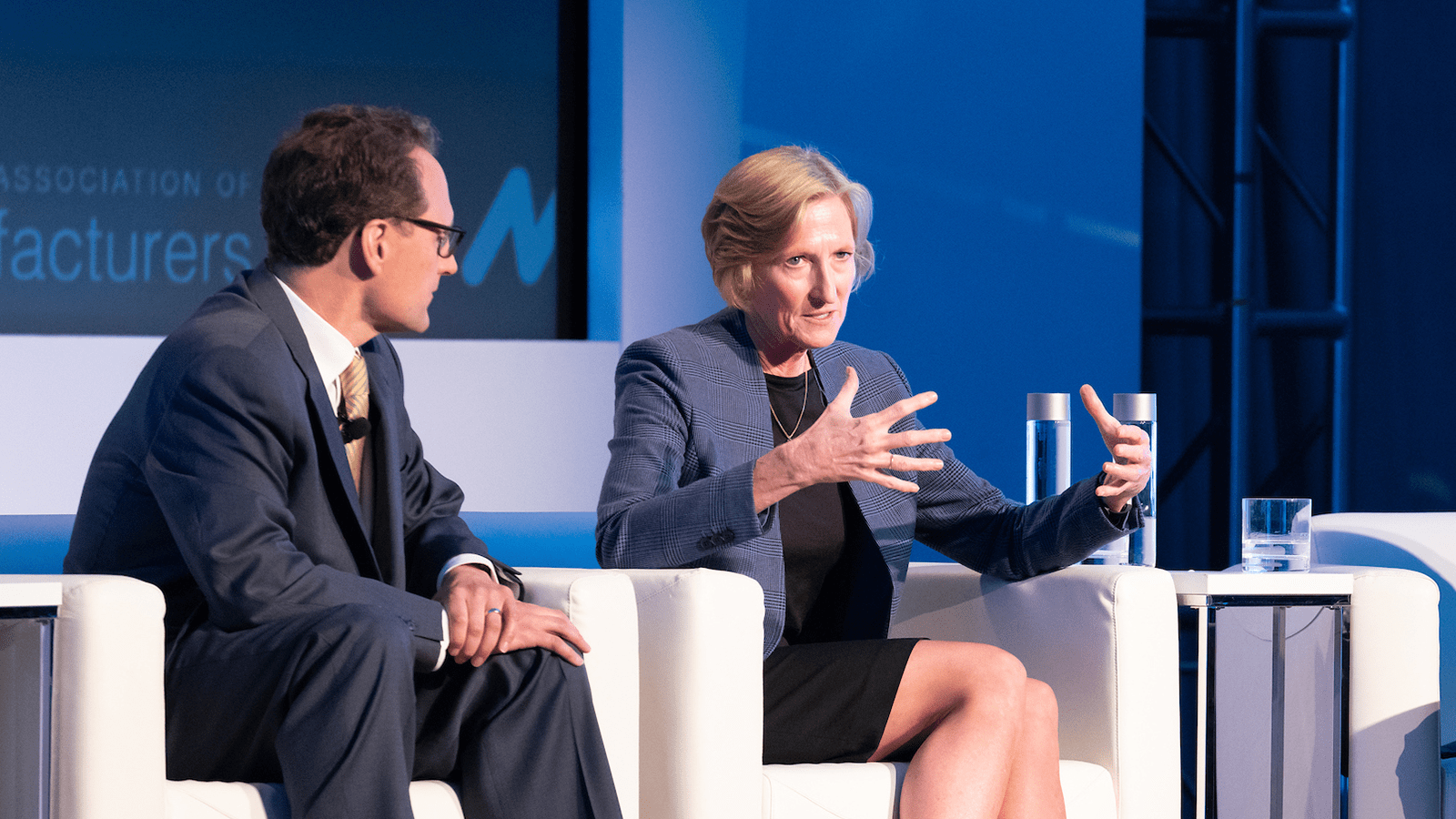
Vicki Holt wants to tell you about digitization. The recently retired CEO of Protolabs, Holt got her start in manufacturing more than 40 years ago and has seen the industry transformed by digital technologies. “By helping manufacturers seize the opportunities of digitization, I believe I am helping them innovate and solve some of the world’s problems,” she explains.
Over the course of her career, Holt led the glass division of PPG, making homes and buildings more energy efficient with solar glazing, then developed sustainable packaging as CEO of Spartech, and from there took charge of digital manufacturing powerhouse Protolabs. We talked to Holt recently about her career, as well as her tenure as the vice chair of the NAM’s Small and Medium-Sized Manufacturers Group, NAM Executive Committee member and as a board member of the NAM’s Manufacturing Leadership Council. Though she has retired from both roles, she remains a key figure in the NAM’s orbit, having recently become a board member at The Manufacturing Institute, the workforce development and education partner of the NAM.
Why the NAM? Holt explains that when she was asked to join the NAM in 2016, she saw it as an opportunity to help manufacturers learn.
- “It was a way for me to get involved and give back, at a time when manufacturing was on the cusp of a new technological revolution,” she says. “I didn’t get involved to influence policy in Washington, but to influence manufacturers themselves.”
By 2017, she had been elected the vice chair of the NAM’s SMM Group, a position she held until her retirement this year. As she notes, the collaboration between the big companies and the smaller ones at the NAM benefits everyone:
- “For example, the big companies were able to dedicate teams to figuring out COVID-19 safety in their factories, and the small and medium-sized companies learned from them. But the big companies also need the smaller ones, because they are essential to supply chains.”
An example of innovation: Holt holds up Protolabs as a prime example of what digitization can do.
- “It used to take companies a long time to innovate, which would stretch out the time for product development. It would take months to make a custom part. Protolabs’ founder broke apart all the things that go into manufacturing a custom injection mold tool and automated the process. What used to take weeks could now be done in a day or two, and all using e-commerce.”
Holt remains an avid watcher of digitization trends, observing that “COVID-19 has accelerated the shift to B-to-B e-commerce throughout the industry, making manufacturers more comfortable connecting to their suppliers digitally.”
Getting manufacturers together: While she was involved with the NAM, Holt also served as a board member of the MLC, which the NAM acquired in 2018 with her encouragement.
- “What I’ve learned through the MLC is that manufacturers are really generous in sharing their learning with other companies,” Holt says. “And that sharing fuels innovation and collaboration.”
- “The MLC complements the NAM,” she adds, “because the NAM is about creating a policy environment that nurtures manufacturing. The MLC is about sharing knowledge about the manufacturing process itself.”
What’s next? Holt is keeping active in retirement. She serves as a board member of several companies—including water heater and treatment maker A.O. Smith Corporation, Waste Management and financial services firm Piper Sandler.
- She is focusing on sustainability in several of these roles and was encouraged to see the Biden administration’s plan for emissions reduction. As she puts it, “If you can unleash manufacturers to innovate, we can reach those targets, even if we don’t have the answers today.”
Holt is also passionate about the mission of the MI:
- “If manufacturers are going to achieve our potential in innovation and digitization, we’ve got to attract people to the industry and show them it’s moved on since the 50s,” she says. “Our frontline employees now solve problems and improve operations in a high-tech environment.”
The last word: Holt says about her time at the NAM, the MLC and the MI, “I’ve just been so impressed with the leaders I’ve met there and their dedication to collaborating and tackling issues like diversity and inclusion. I really appreciate the opportunities afforded to me by being involved in these organizations.”
The State of Manufacturing in 2021

NAM President and CEO Jay Timmons delivered his 2021 State of Manufacturing Address today, focusing on key priorities for manufacturers as we emerge from the COVID-19 pandemic. Marlin Steel Wire Products, a Baltimore-based wire and sheet metal fabricator, hosted the event at its facility.
How manufacturers adapted: Timmons lauded the ways in which manufacturers adapted to the constraints of the pandemic by using tools like augmented reality and virtual reality, which allowed them to remain productive even while workers had to remain distant from one another. He also highlighted individual examples of manufacturers who embraced innovation to respond to COVID-19.
- “Marlin Steel reworked their shop floor so that they could answer an emergency order for test-tube racks for COVID-19 testing—something they’d never made before.”
- “W.L. Gore, the makers of Gore-Tex in nearby Delaware, donated their fabric laminate for protective gowns and supplied their material to make N95 masks, helping doctors breathe easier.”
- “Oldcastle BuildingEnvelope, headquartered in Dallas, Texas, invented a portable clean room—a small glass enclosure that shields health care workers from patients.”
- “And iconic automakers nationwide stepped up to produce face shields and ventilators.”
Boosting vaccines: Timmons thanked manufacturers nationwide who have led the effort to get employees vaccinated against COVID-19, stressing the importance of the vaccination campaign.
- “This is such a powerful example of how vaccine manufacturers are helping all manufacturers, and all Americans, get our lives back. This is how we save our economy. This is how we protect our loved ones. This is our shot to end this pandemic. And manufacturers stand behind the COVID-19 vaccines and encourage all of our fellow Americans to get them. The vaccine is also one important reason why manufacturers see the light at the end of the tunnel leading to the next, post-pandemic world.”
What’s next: Timmons offered proposals for how America can lead manufacturing into the future through bold investments in infrastructure, support for research and development, bolstering supply chains in the United States and ensuring a diverse workforce, all without going back to “the archaic tax policies of the past.”
- “Our industry isn’t focused on just going back to the way things were. We want to build a better world—one that offers an abundance of opportunity to every American.”
Manufacturers’ voices: A number of manufacturing workers and leaders were featured during the speech to help describe the state of manufacturing. They included:
- Sharon Kaul, First-Shift Socket Machine Operator at Snap-on Incorporated
- Lisa Winton, CEO and Co-Owner of Winton Machine
- Cassandra Hawkins, PS&D/Quality Manager at International Paper
- Luis Martinez, Outside Sales Representative at Click Bond
- Patricia Miller, CEO of MATRIX 4, Inc.
- Juan Rigoza, Weld Technician at Vermeer Corporation
- Kevin Carpenter, Plant Manager at LP Building Solutions
- Jose R. Esparza of Gowan Milling LLC
- Steve Macias, Co-owner of Pivot Manufacturing
- Frank Bautista, Supply Base Manager at ALOM
The last word: As Timmons said, “Manufacturers simply do not accept the notion that anything is impossible. If we can now develop vaccines in less than a year or remake our shop floors in a week, we can build the world we want to see. Manufacturers are not victims of history, never have been. Because we literally build the future.”
How a Manufacturer Left Landfills Behind
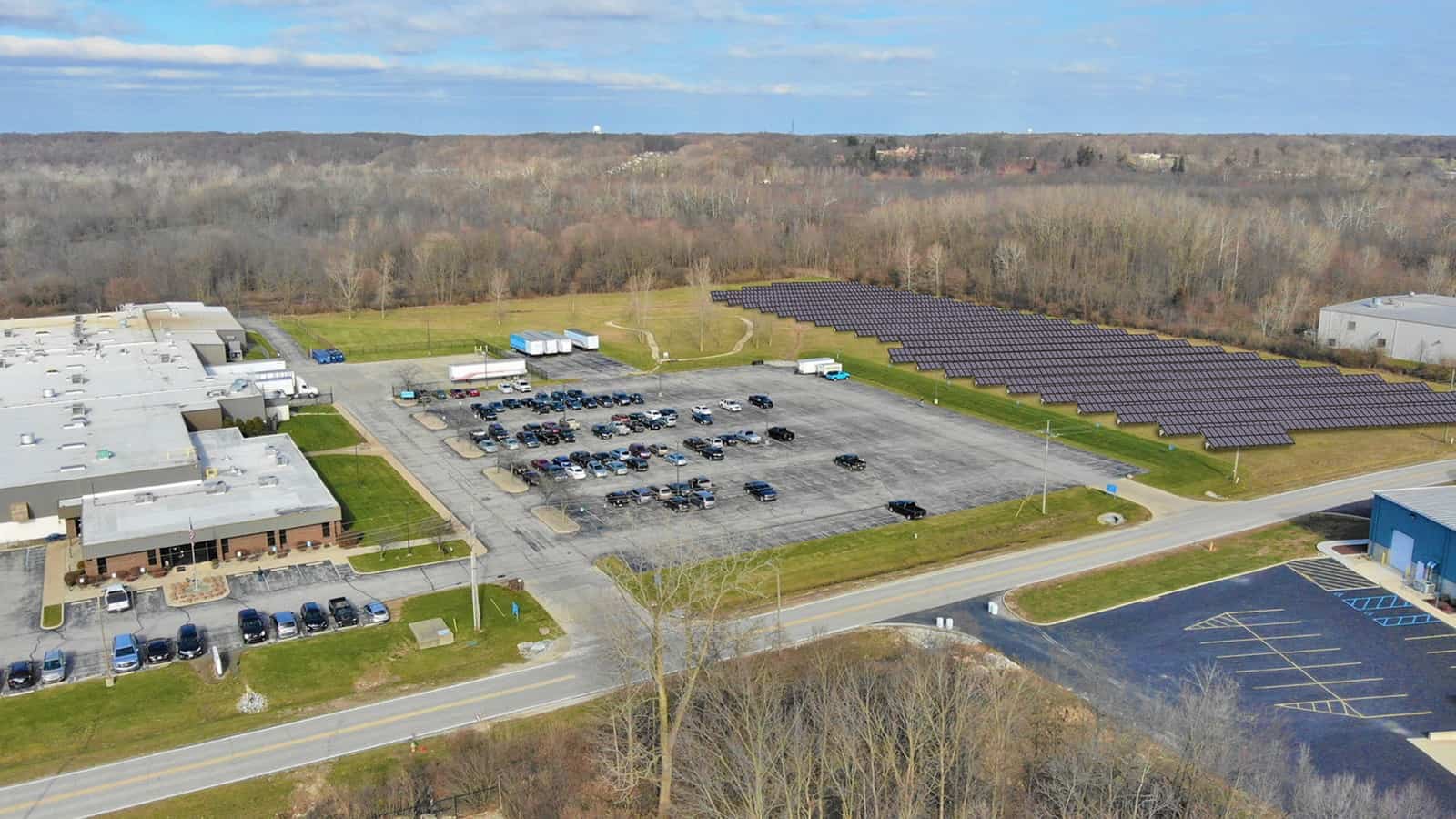
Bendix Commercial Vehicle Systems sends almost none of its waste to landfills. A manufacturer of safety, air management and braking system technologies, the company cut its energy use by 14 million kilowatt-hours over the past six years. And it’s now building a 1.168-megawatt solar array near its Indiana facility.
That’s only the start for the Ohio-based manufacturer. In the past few years, Bendix has become a leader in sustainable manufacturing, adding sustainable design to its buildings and emphasizing sustainability in everything from employee training to production. The company has also been recognized for its achievements: In April 2020, Bendix received an award for “environmental excellence” from the Ohio Environmental Protection Agency, and recently the company won an award from the U.S. Department of Energy for its outstanding energy management.
“Even during a year when many activities had to be modified, curtailed or held remotely, our team members stayed true to our sustainability mission and to our overall energy strategy,” said Bendix Director of Corporate Responsibility and Sustainability Maria Gutierrez.
So how did they do it?
What it takes: “Our approach is built on a hierarchy that calls for each location to first eliminate, then reduce, reuse, recycle and reclaim—and as a final option when these strategies are not available, to utilize waste-to-energy technologies or incineration,” said Bendix Corporate Manager of Environmental and Sustainability Bill Schubert.
- The entire company sent fewer than 16 tons of material to landfills in 2020, a 97% decrease from the 508 tons in 2019.
- Bendix has done everything from eliminating plastic water bottles and Styrofoam to conducting “spent material audits”—more commonly known as dumpster dives—to ensure recyclables don’t go to waste.
- Its 4,100 employees are also chipping in: worker-led teams coordinate “green” projects, which continued even during the pandemic.
What’s next: At its Huntington, Indiana, manufacturing campus, Bendix is constructing a solar array that is expected to be operational in September 2021. It will produce more than 30% of the site’s electricity requirements and is slated to save $140,000 in utilities annually.
- Bendix also aims to cut carbon emissions in half by 2030 across its entire North American operations. The larger goal: to be entirely carbon neutral by 2050.
The last word: “Taking a creative approach to addressing challenging waste and improving energy efficiency remained a key theme for Bendix during all of 2020, and our efforts certainly paid off,” said Gutierrez. “Now, we’re focused on the next steps of our long-term energy plans, which are just as exciting.”
How One Manufacturer Inactivates COVID-19
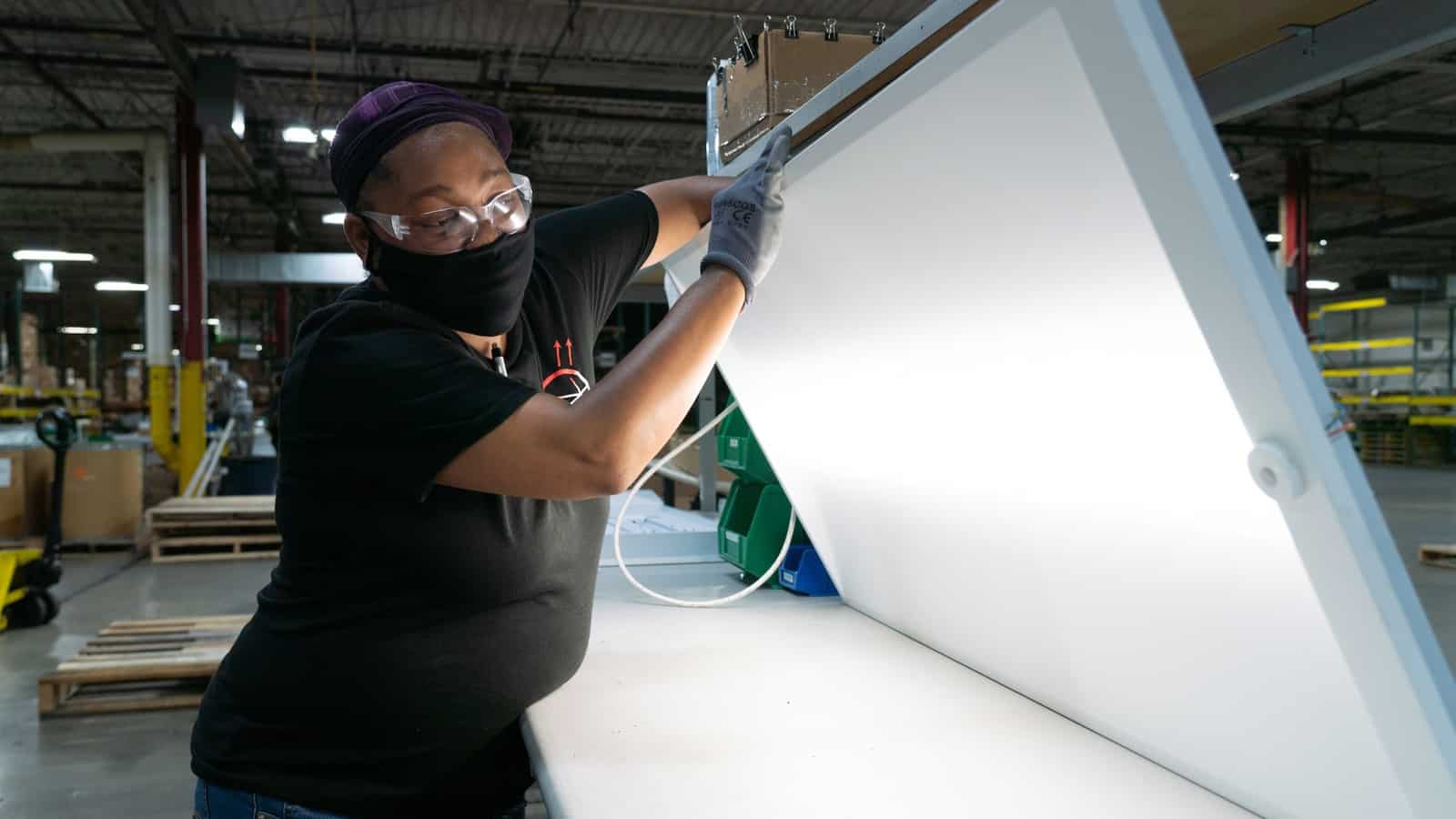
When COVID-19 upended their operations, LumenFocus—a manufacturer of LED light fixtures—saw an opportunity to be of service. It quickly pivoted to developing products that inactivate viruses and kill bacteria with certain UV wavelengths, called UVC wavelengths. These products, which may be used in businesses, schools and hospitals, can make shared environments safer for everyone.
The company’s new solutions also caught the attention of the military. Recently, the Department of Defense awarded LumenFocus a significant portion of a $2.3 million contract to develop a prototype for military operations. LumenFocus President and CEO Charles Kassay said after the announcement, “As an American company, we are thrilled at the opportunity to be developing products to help our servicemen and servicewomen.”
So how did LumenFocus come up with these virus-inactivating fixtures?
How they did it: Before the pandemic, LumenFocus had only manufactured LED light fixtures. But when COVID-19 hit, the company directed its R&D teams to research solutions for eradicating pathogens like COVID-19.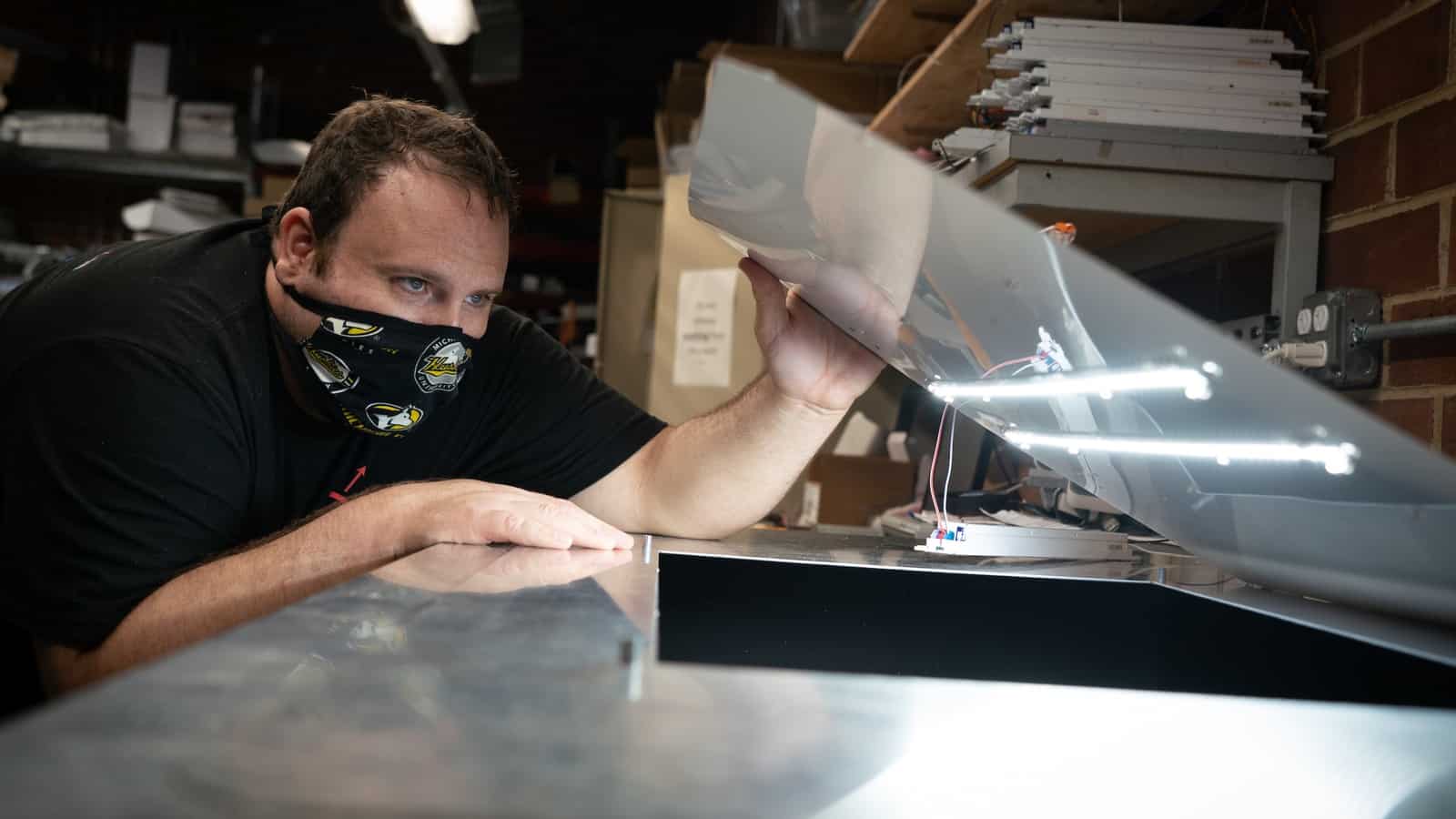
- “We knew about ultraviolet light and its potential for disinfection, but it wasn’t an avenue we had traversed before,” says Marketing Coordinator Eric Robinson. “Once we understood the science behind UV, we combined this with our knowledge and experience in engineering light fixtures, and our fabrication capabilities, to create products for pathogen eradication.”
What they’re making: LumenFocus speedily developed a range of products that offer different means of sanitization for different customers’ needs. Some include:
- The new PathogenFocus product line: These products use nonthermal plasma technology for continuous air and surface disinfection in buildings, either in conjunction with existing HVACs or as standalone units. They have been scientifically proven to reduce up to 99.99% of common pathogens (including bacteria and viruses) quickly and effectively, according to the company.
- Direct UVC units for unoccupied rooms: These products are intended for unoccupied spaces, as they provide a high dosage of UVC to eradicate pathogens quickly. The UVC fixtures can be ceiling mounted or recessed into grid ceilings.
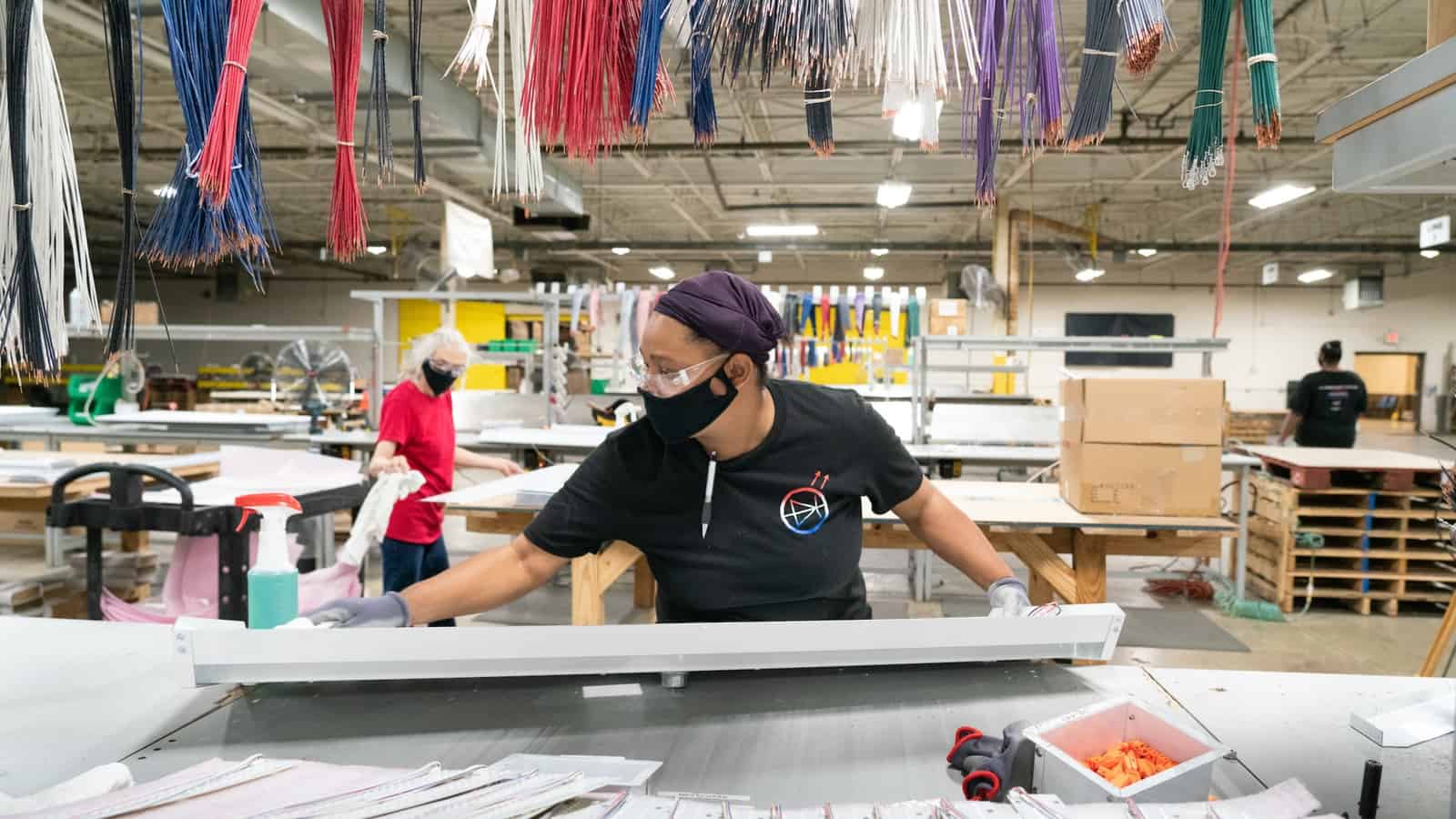
- Germicidal upper air units: These fixtures can be used in occupied spaces, as the UVC treats only the upper zone in the room, not the lower zone where people are. As the air circulates, it flows into the plane of UVC irradiation, where the pathogens are killed or inactivated.
- A portable UVC Tower that can be wheeled around to unoccupied rooms, such as classrooms or offices, and which uses a higher dose of UVC to eradicate viruses and bacteria in a very short time.
The last word: As Kassay says, “The LumenFocus team has been tirelessly working on ways to implement pathogen-eradicating technology. Lighting is just one area where we can help—and that’s an area where we have a lot of experience. Our goal is to develop solutions that will help Americans get back to work in safer, healthier environments. And, if a similar unfortunate situation like COVID-19 arises in the future, we hope that these solutions can help us fight it.”
How Small Manufacturers Can Use Cutting-Edge Tech

As manufacturing goes through digital transformation, small to medium-sized manufacturers have just as much opportunity to reimagine their operations as large businesses. And to help these companies think through their options, the NAM and Stanley Black & Decker got together to host a Creators Wanted virtual session on making use of “Industry 4.0” technologies.
Who participated: NAM President and CEO Jay Timmons, Connecticut Gov. Ned Lamont and Stanley Black & Decker CEO Jim Loree spoke at the event. Other business leaders and government officials, including Connecticut Business & Industry Association President and CEO Chris DiPentima, also joined the session.
Inside Manufacturing 4.0: “All of us want to be a part of Manufacturing 4.0, a fourth Industrial Revolution in manufacturing, powered by digital and smart technology,” said Timmons. “There’s literally no business that can’t benefit from tapping into digital transformation. And today’s event is about demonstrating that keeping your business state of the art, on the cutting edge, is truly easier than you think.”
Why now? U.S. manufacturing is at a pivotal moment and will play a central part in the ongoing economic recovery. Adopting digital tools should be a part of the strategy, according to Loree.
- “As every one of us strives to put the health challenges of the pandemic in the rearview mirror, we all have a responsibility to assist with the economic recovery that must follow,” he said. “Manufacturing must and will play a critical role, and we can supercharge it.”
Getting started: One key tool under discussion was the Smart Industry Readiness Index Assessment, a comprehensive technology evaluation and independent review that can help businesses modernize.
- Bead Industries CEO Jill Mayer said at the event that what she needs as an executive is a snapshot of the current technology landscape and an understanding of her company’s future needs. That’s what a SIRI assessment can deliver.
- The assessment, which takes roughly two days, can help identify technology gaps and inefficiencies, while also helping companies create structured plans for purchasing equipment. The reviews are conducted by certified assessors who understand manufacturing and can help businesses through this key transition.
A broader landscape: In addition to individual innovations and technology, Stanley Black & Decker Chief Technology Officer of Global Operations Sudhi Bangalore cited the importance of innovation and economic manufacturing ecosystems.
- A strong innovation ecosystem can include government experts, upskilling programs, a thriving community of small and medium-sized enterprises and more, according to Bangalore.
- Gov. Lamont added that Connecticut is home to one such ecosystem and cited manufacturing education as a crucial area where government and industry can work together to grow the economy.
Closing thoughts: “I would consider this next year an extraordinary opportunity as we change the way we do business in state government and what we do in manufacturing,” said Gov. Lamont.
To watch the whole session, click here.
How Tax Reform Helped Optimax Invest in Workers

After the passage of tax reform in 2017, the lower corporate tax rate and faster tax depreciation of capital equipment purchases enabled Optimax Systems—a manufacturer specializing in optics for semiconductor, aerospace and defense technologies—to reinvest in its workers and operations.
Hiring new workers: Since 2018, the New York manufacturer has hired aggressively, increasing its full-time headcount from 290 to 340. It has also raised salaries for employees, with an average annual increase of 4.8% since 2017—well above the company’s annual increases before 2017. Optimax sees the increases in hiring and wages as a vote of confidence in its workforce—and as a way to pay forward the benefits of tax reform.
Expanding their operations: Since 2018, Optimax has doubled the size of its manufacturing facility, increasing the space from 60,000 square feet to 120,000 square feet. The company also increased investment in equipment, boosting its annual investment from an average of roughly $3 million per year between 2014 and 2017 to an annualized rate of more than $7 million per year since 2018.
What we’re doing: To support companies like Optimax and its customers, the NAM is leading the effort to ensure that the tax code continues to incentivize growth, as well as working to make manufacturers’ priorities and concerns known to the Biden administration and lawmakers. For companies like Optimax, maintaining the competitive tax rate is critical, which is why the NAM is vocal about the potential harm of tax hikes.
The costs of tax hikes: A new study conducted by Rice University economists for the NAM found that increasing the corporate tax rate along with other harmful tax changes could lead to 1 million fewer jobs in the first two years.
- “As we slowly emerge from the economic catastrophe caused by COVID-19, American businesses are at a pivotal point in our nation’s history,” said NAM President and CEO Jay Timmons. “Manufacturers can, and should, lead the economic recovery in the wake of the pandemic. But this study tells us quantitatively what manufacturers from coast to coast will tell you qualitatively: increasing the tax burden on companies in America means fewer American jobs.”
The last word: “Optimax has a mission of enabling customer success and employee prosperity. We have learned, through 30 years of experience, that there is no better way to do this than to reinvest our profits back into the business and back into our people,” said Optimax Controller Tom Starin. “Tax reform has freed up an additional piece of the profit pie, allowing the company to double down, quite literally, on our mission of enabling customer success and employee prosperity.”
How PTC Onshape Powers the FireFly ESV’s Engineering Teams
The NAM’s Makers Series is an exclusive interview series featuring creators, innovators and trailblazers in the industry sharing their insights and advice. Meet David Solomont and Greg Horne from ev Transportation Services, Inc., which makes the FireFly ESV vehicle. In this edition of the NAM’s Makers Series, Solomont and Horne explain how ev Transportation Services uses PTC’s Onshape cloud-based CAD system to power its distributed manufacturing and engineering teams working on the FireFly ESV.
Lilly Invests in the Health of Marginalized Communities

Eli Lilly is working with a new venture capital firm to help underrepresented communities receive better health care.
The project: Lilly has invested $30 million in a partnership with Unseen Capital Health Fund LP, a newly formed venture fund built by racially diverse business leaders that is intended to identify and support early-stage minority-owned health care companies. The group hopes to fund up to 50 companies and raise a total of $100 million—and with Lilly’s support, it’s well on the way.
The fund will focus especially on health equity, digital innovation and the social determinants of health. Underrepresented founders often have firsthand knowledge of the limitations of the traditional health care system, as Unseen Capital’s general partner Kayode Owens told Bloomberg (subscription).
Why it matters: Black Americans and other people of color have long suffered significant disadvantages in health care—and have done so again during COVID-19. People of color are also underrepresented in pharmaceutical and other health-related industries, as well as among venture capital firms that could improve the situation. Unseen aims to change the fates of “unseen” communities, by combining the expertise of racially diverse investors with the insight of underrepresented founders.
Other efforts: In addition to the partnership with Unseen Capital, Lilly has also taken a range of measures to help promote racial justice, including by expanding diversity in clinical trials; working with other major companies through the OneTen coalition to hire, train and advance Black Americans into 1 million jobs; and doubling Lilly’s spending with diverse suppliers.
Lilly says: “Driven by unprecedented innovation, health care is attracting record levels of investment. To unleash the full potential of innovation in our sector, historically underrepresented founders need to receive more growth capital,” said Philip Johnson, Lilly’s senior vice president and treasurer. “With this capital, these founders can catalyze systemic change while improving health outcomes for society. Providing our financial and knowledge resources to Unseen Capital is an opportunity for Lilly to be an agent for change in a way that is authentic to our purpose and culture.”
Unseen says: “Solving for equitable health care is the challenge of the 21st century,” Owens told Bloomberg. “While Covid-19 laid bare the inequities of our health-care system, George Floyd’s killing laid bare the inequities of our justice system. We need to bet on underrepresented founders to be the agent of that change.”
The NAM’s commitment: In June, the NAM Executive Committee unanimously approved a Pledge for Action intended to close the opportunity gap by taking 50,000 tangible actions to increase equity and parity for underrepresented communities. The initiative is supported by The Manufacturing Institute. Make your commitment here.
How to Talk to Employees About Vaccines

As the U.S. vaccine rollout expands to nearly all adults, manufacturers are figuring out how to encourage workers to be vaccinated. To help them, the NAM and The Manufacturing Institute are providing resources and advice through their This Is Our Shot project. Most recently, the project hosted a webinar to help employers frame conversations about vaccines, called Employer COVID-19 Vaccine Communications: Do’s and Don’ts. Here are some of the highlights.
The participants: The webinar was hosted by NAM Vice President of Brand Strategy Chrys Kefalas, the NAM lead of the This Is Our Shot project. It featured Ann Searight Christiano, director of the Center for Public Interest Communications at the University of Florida, and Jack Barry, a postdoctoral research associate for the University of Florida’s Center for Public Interest Communications.
Why communication matters: “The vaccines are becoming widely available and so people are really at a point where they no longer have to wait. It’s time,” said Christiano. “But as employers, you have a great deal of influence and trust with your employees and are well positioned to help build their trust and encourage them to get those vaccines.”
What to think about when you talk about vaccines: According to Christiano and Barry, there are eight factors to think about when developing vaccine communications: worldviews, timing, messengers, narratives, relationships, social norms, emotions and motivations. Christiano and Barry recommend taking people as they are—and responding to their particular identities and values.
Think about who and when: The timing and the messengers are extremely important. National health professionals are far more trusted on pandemic advice than celebrities, for example. People generally want messengers from their own communities, too. Think of the “influencers” in your workplaces—the respected leaders, the trusted employees—and consider using them in your campaigns, say Christiano and Barry.
The message itself: Use specifics to show how important it is to get vaccinated, such as that vaccines allow you to travel or hug your grandparents. And use the themes of choice, regret and control—often cited by vaccine hesitators—and frame them in a positive way to increase vaccine uptake.
Things to avoid: Don’t amplify people’s concerns and avoid appeals to unpleasant emotions like shame and fear, the researchers advise. Consider instead using pleasant emotions like pride, joy and parental love. Consider the motivations of the messenger, too. Be transparent and honest about why you want people to get vaccinated.
The last word: “Our role is to help all manufacturers get fact- and science-based information to safeguard workplaces and communities and to help end this pandemic. We’ll continue hosting webinars, curating the most effective tools available and deploying other research-proven resources at NAM.org/ThisIsOurShot,” says Kefalas.
For more details on how to create communications for your employees, check out the whole presentation here.
